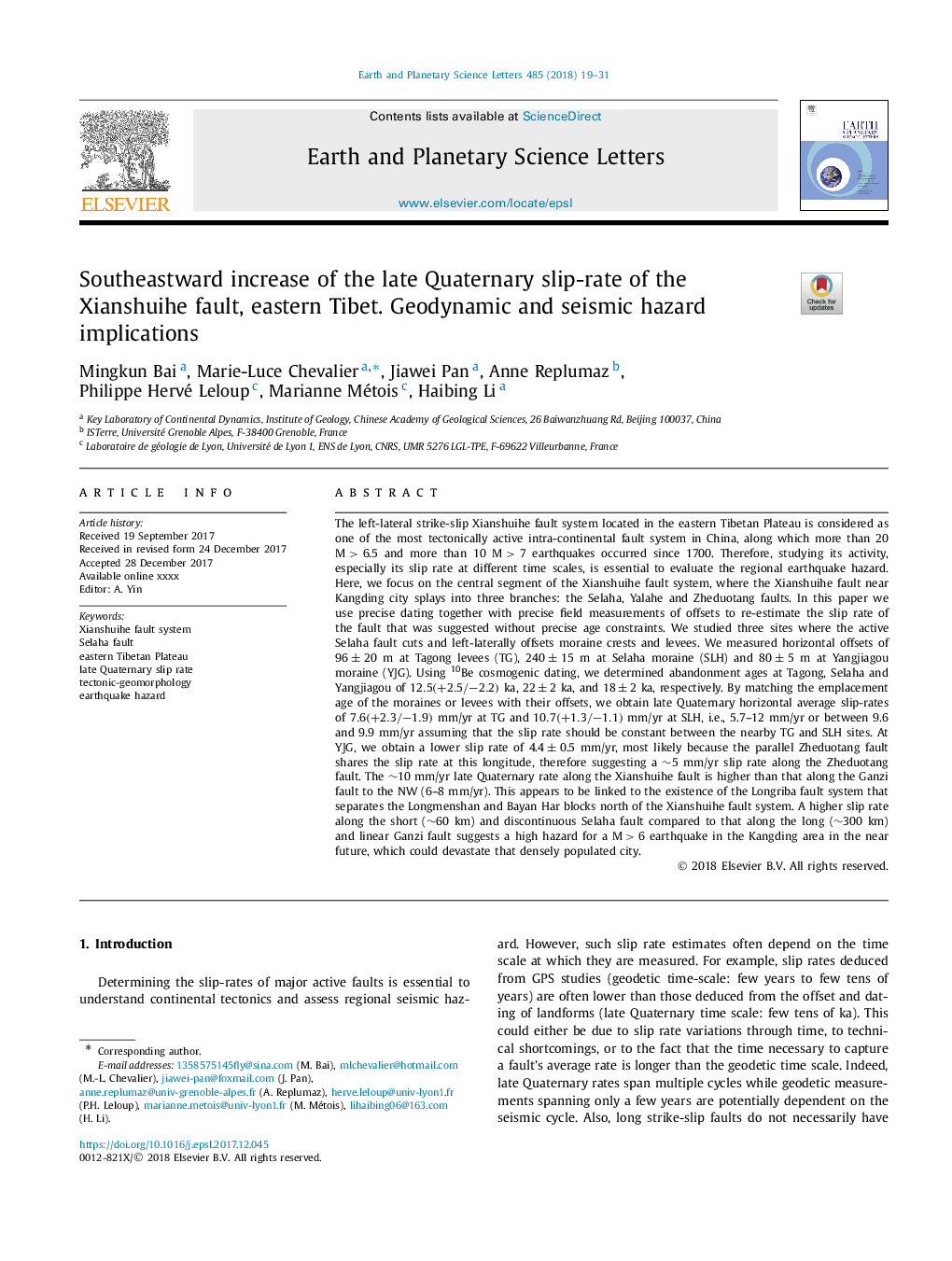| کد مقاله | کد نشریه | سال انتشار | مقاله انگلیسی | نسخه تمام متن |
|---|---|---|---|---|
| 8907118 | 1634671 | 2018 | 13 صفحه PDF | دانلود رایگان |
عنوان انگلیسی مقاله ISI
Southeastward increase of the late Quaternary slip-rate of the Xianshuihe fault, eastern Tibet. Geodynamic and seismic hazard implications
دانلود مقاله + سفارش ترجمه
دانلود مقاله ISI انگلیسی
رایگان برای ایرانیان
موضوعات مرتبط
مهندسی و علوم پایه
علوم زمین و سیارات
علوم زمین و سیاره ای (عمومی)
پیش نمایش صفحه اول مقاله

چکیده انگلیسی
The left-lateral strike-slip Xianshuihe fault system located in the eastern Tibetan Plateau is considered as one of the most tectonically active intra-continental fault system in China, along which more than 20 M > 6.5 and more than 10 M > 7 earthquakes occurred since 1700. Therefore, studying its activity, especially its slip rate at different time scales, is essential to evaluate the regional earthquake hazard. Here, we focus on the central segment of the Xianshuihe fault system, where the Xianshuihe fault near Kangding city splays into three branches: the Selaha, Yalahe and Zheduotang faults. In this paper we use precise dating together with precise field measurements of offsets to re-estimate the slip rate of the fault that was suggested without precise age constraints. We studied three sites where the active Selaha fault cuts and left-laterally offsets moraine crests and levees. We measured horizontal offsets of 96 ± 20 m at Tagong levees (TG), 240 ± 15 m at Selaha moraine (SLH) and 80 ± 5 m at Yangjiagou moraine (YJG). Using 10Be cosmogenic dating, we determined abandonment ages at Tagong, Selaha and Yangjiagou of 12.5(+2.5/â2.2) ka, 22 ± 2 ka, and 18 ± 2 ka, respectively. By matching the emplacement age of the moraines or levees with their offsets, we obtain late Quaternary horizontal average slip-rates of 7.6(+2.3/â1.9) mm/yr at TG and 10.7(+1.3/â1.1) mm/yr at SLH, i.e., 5.7-12 mm/yr or between 9.6 and 9.9 mm/yr assuming that the slip rate should be constant between the nearby TG and SLH sites. At YJG, we obtain a lower slip rate of 4.4 ± 0.5 mm/yr, most likely because the parallel Zheduotang fault shares the slip rate at this longitude, therefore suggesting a â¼5 mm/yr slip rate along the Zheduotang fault. The â¼10 mm/yr late Quaternary rate along the Xianshuihe fault is higher than that along the Ganzi fault to the NW (6-8 mm/yr). This appears to be linked to the existence of the Longriba fault system that separates the Longmenshan and Bayan Har blocks north of the Xianshuihe fault system. A higher slip rate along the short (â¼60 km) and discontinuous Selaha fault compared to that along the long (â¼300 km) and linear Ganzi fault suggests a high hazard for a M > 6 earthquake in the Kangding area in the near future, which could devastate that densely populated city.
ناشر
Database: Elsevier - ScienceDirect (ساینس دایرکت)
Journal: Earth and Planetary Science Letters - Volume 485, 1 March 2018, Pages 19-31
Journal: Earth and Planetary Science Letters - Volume 485, 1 March 2018, Pages 19-31
نویسندگان
Mingkun Bai, Marie-Luce Chevalier, Jiawei Pan, Anne Replumaz, Philippe Hervé Leloup, Marianne Métois, Haibing Li,